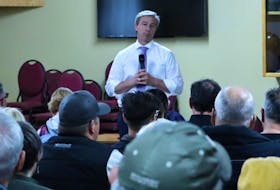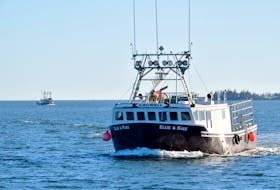JOGGINS, N.S. – For a small group of passionate researchers who have dedicated countless man-hours to unearthing and unravelling the mysteries of the Joggins Fossil Cliffs, one burning question weighs heavily on their minds.
What new discoveries could soon be brought to light?
Inquisitive by nature, their new-found enthusiasm centres around a shipment of fossilized trees they carefully crated last month and delivered to their new temporary home at Carleton University in Ottawa.
Within the 300-million-year-old trees are the fossilized remains of the world’s earliest known reptiles and amphibians. That much they know. What other secrets are entombed within the ancient trees? That’s the question they trust will soon be answered.
OLD SCIENCE LEADS TO NEW DISCOVERIES
John Calder, a senior geologist with the government of Nova Scotia and paleontologist, said they relied on century-old science to locate the fossilized trees.
The same type of specimens, Calder explained, were first discovered at Joggins in the 1800s by Sir William Dawson, who became a principal at McGill University.
“He spent his lifetime working on collecting these trees and these fossils . . . he had a search strategy that nobody else was able to reproduce over the next century. Countless decades of field excursions by eminent vertebrate paleontologists from various universities had been unsuccessful in finding anything.
“That changed in 1995 when a colleague from England, Dr. Andrew Scott, and myself . . . we started reinvestigating the nature of how the creatures came to be within the trees …we learned that Dawson had handed the keys over, but people hadn’t been willing to take them. He gave a description of where exactly in the trees these fossils occur, in what kind of rock they occur and he basically (provided) the map for how to find them. And yet people had kind of overlooked his writings, I think, as being old and antiquated.”
After consulting Dawson’s early work, Calder said “it was like the walls came down and we started finding more and more trees with reptiles and amphibian bones in them.”
Calder said several people were instrumental in collecting the fossils but paid special recognition to one man, Brian Hebert, who was responsible for finding most of the fossilized trees.
“Brian is, in my years as a geologist and paleontologist, the most gifted. I call him a paleosleuth. He has an ability to find fossils, not through sheer luck, but through careful scrutiny of the rocks.”
Most of the collected tree fragments ended up in Andrew MacRae’s fossil lab at Saint Mary’s University, Calder said, where they were painstakingly reassembled into their original form.
“When they fall from the cliffs they break apart and it’s like putting Humpty Dumpty back together again.”
After this step was completed, Calder said they had one key question.
“We wanted to know exactly where the bones occur in the trees so we could untangle the story of how on earth these creatures got to be there in the first place.”
NEW TECHNOLOGY MAY PROVIDE ANSWERS
Calder said the recent addition of Carleton University’s Dr. Hillary Maddin to their existing team of researchers may finally unlock the answers they’ve been seeking for decades.
“Hilary is a really bright light. She’s a phenomenal young vertebrate paleontologist ... At her lab at Carleton she has the facilities to do CAT scanning of the trees so you can see where, three-dimensionally, the bones are within the trees.
“She has the expertise of graduate students trained in vertebrate paleontology who know the names of the various amphibians and reptiles of the day and can actually do this next painstaking part of the puzzle.”
Calder said they expect to start receiving answers within a year.
HISTORY REPEATS
Calder noted the fossilized trees recently sent to Carleton marked something of a milestone.
“That was the biggest shipment of fossil-bearing trees to leave Joggins since the 1800s when Dawson would have shipped them out by horse and wagon and possibly rail on the way back to McGill.”
Calder said he is confident the fossils now in the care of Carleton University will reveal never-before-seen discoveries.
“Joggins has this huge claim to fame based on the work of Dawson, primarily, and now we have a cache of fossil-bearing trees that could well equal or surpass the discoveries that were made by Dawson.
“I have no doubt that in those trees are creatures that haven’t seen the light of day for 300 million years, that no human being has ever seen before . . . it’s not just the exercise of naming them, it’s putting new branches on the tree of life, and that shipment that went to Carleton is going to do just that.”








